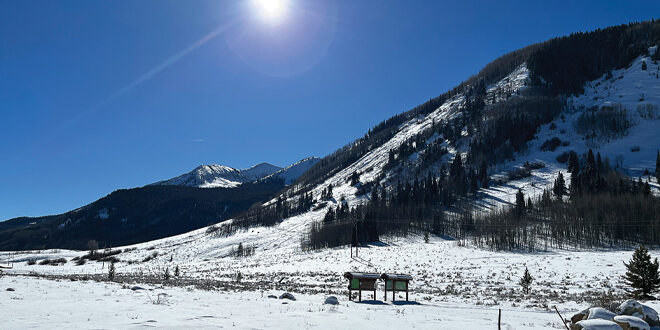Hydro and solar initiatives still expected to be ready in 2024
By Mark Reaman
Two local renewable energy projects, one solar and one hydro, are anticipated to come online by next summer despite some recent timing issues. Delays with both the Taylor River Hydro project, and what is now being called the Oh Be Joyful solar project (formerly Avalanche Park) just south of Crested Butte at the Baxter Gulch trailhead, have hindered the projects that are anticipated to provide sustainable energy to the Gunnison County Electric Association (GCEA) power system. Ultimately, the two projects could supply 6,400 megawatt hours per year to the GCEA system, or approximately 5% of its needed energy.
The Taylor River Hydro project has experienced two significant delays. According to GCEA strategy execution specialist Matt Feier, the first delay occurred at the metal building manufacturing facility in Texas when a plasma cutter went offline for more than a month. This manufacturing equipment failure has been resolved, and he said GCEA expects to receive the metal building onsite for assembly in mid-December.
“The second delay occurred at the generator manufacturing facility in Minnesota when a specialized manufacturing tool went down for repairs for several weeks,” Feier explained. “The specialized tool has since been repaired. The generator is now fully constructed and has been shipped to Washington state for mating with the fully constructed Taylor River Hydro hydroelectric turbine.”
Once the turbine and generator are joined and tested, they will be shipped as one unit to the project site for installation within the assembled metal building. “We are hoping this can all occur before the end of 2023, but weather may require greater flexibility,” Feier said. “Once the metal building, turbine and generator are safely onsite, some station service activities will occur throughout the winter. Those include work like installing heat, lights, control systems, etc.”
When the winter’s snowfall begins to melt at the base of the dam, Feier said the construction team will excavate between the existing valve house and the new hydroelectric facility, install the new penstock and make the necessary connections on either end.
The existing penstock is currently being fitted to accept this connection. A penstock is the pipe used to transport the water from the dam to the turbine that generates the electricity.
New fiber optic cable will also be pulled within conduit that has already been installed, and two transformers will be set and connected. Feier said that then, testing and commissioning can occur, and operations can begin. “We are still aiming to have this new facility up and running by late spring 2024,” he said.
Solar gaining
Meanwhile, the Oh Be Joyful solar project that will be located at the Baxter Gulch trailhead just south of Crested Butte on Highway 135 was originally slated to start construction in 2022 but is now going through the county approval process.
“The proposal is currently being reviewed within the Gunnison County Land Use Resolution, Minor Land Use Change review and approval process. The project developer, Outshine Solar and Gunnison County have been in regular communication with the GCEA and the town of Crested Butte staff regarding site design details, and there may be a public hearing for this proposed project soon,” Feier explained. “Assuming this proposed project is approved within the Gunnison County LUR (Land Use Resolution) process, the developer intends to complete construction and commissioning of the solar array in the summer of 2024.”
The goal is to locate a 1.125 (Alternating Current) megawatt solar array on the town-owned site that has been leased to Outshine for 30 years. The town of Crested Butte has agreed to subsidize the cost of electricity produced at the site over the next three decades. The GCEA wants to keep the playing field level for all its members and bring in the cost of the electricity produced at the solar farm at the same rate as it pays its main wholesale electricity provider, Tri-State Generation and Transmission Association, Inc., so the town is essentially agreeing to subsidize the cost of the solar electricity from 6.8 cents to 4.3 cents per kilowatt hour. The premium is expected to cost the town between $29,260 and $39,047 per year over the next three decades. Not all of the anticipated RECs (Renewable Energy Credits) used to subsidize the project have been purchased, with about 12% still available, but Feier said the GCEA hopes to be able to sell the remaining RECs once construction on the site begins.
More solar potential
The GCEA is also in the initial stages of exploring another 800-kilowatt community solar garden. That would be located nearer to the city of Gunnison and could provide an opportunity for GCEA customers to lease renewable energy shares toward their bill.
Based on expectations, the Taylor River hydro project should power approximately 450 local houses for a year while the Oh Be Joyful solar array could provide daytime energy to approximately 900 homes while lowering the amount of greenhouse gas emissions attributed to the town accounts.
 The Crested Butte News Serving the Gunnison Valley since 1999
The Crested Butte News Serving the Gunnison Valley since 1999



